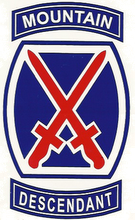Conquest of the locality Felicari. By Dillon Snell
ITALY 1944-1945
I was a 20 ½ years old Platoon Sergeant (Technical Sergeant; after a First Sergeant, the most senior Non Commissioned Officer). I had been in the Army 19 Months and had trained with the Division at Camp Hale Swift Texas, near Bastrop. As Platoon Sergeant I was the senior enlisted man in the platoon of about 35 soldiers. A second lieutenant was the Platoon Leader. I was assigned to the Company L, 3rd Battalion, 86th Mountain Infantry, 10th Mountain Division.
We left Norfolk (Hampton Roads) Virginia on Dec 10th 1944 on the SS Argentina for a 13 day voyage on this unescorted troop ship. No problems and arrived in Naples, Italy on Dec 24th.
Moved to a  bombed out college [? Bagnoli], in Naples. We stayed two days until December 26th when we were transferred of Leghorn aboard an Italian freighter, the Sestrerie. This was a bad overnight trip on a dirty, uncomfortable boat.
bombed out college [? Bagnoli], in Naples. We stayed two days until December 26th when we were transferred of Leghorn aboard an Italian freighter, the Sestrerie. This was a bad overnight trip on a dirty, uncomfortable boat.
Arriving in Leghorn December 27th, we went to a bivouac area 3 miles from Pisa and later by truck to the San Marcel area for training. Co L sent out a 58 man patrol on Jan 14th. No contact. On Jan 18th Co L sent out a 53 man patrol. That was a fiasco. Objective was to take Piansinatico. I was not involved in either action.
Jan 20th Co L moved to Querciola (we called it Coca Cola) at the base of Mt Belvedere, in the Apennine range (Bolognese) north of Florence. We established strong points in the many farmhouses in the area. We named them for fierce animals. Civilians had evacuated this no man’s land. On Jan 24/25th a German patrol attacked. There was a firefight at “Rattlesnake” and “Lion”. (The other occupied farmhouse was “Bear”.) In June 1997 on the Reunion tour, “Rattlesnake” was identified on the road from Querciola, about 3 miles from Vidiciatico. Could not find “Lion” or “Bear”.
Co L was withdrawn to Vidiciatico. Later it was sent to San Casein as reserve, and for break. From early January to mid February we were on outpost duty, patrolling, training, resting, and getting broken in to the combat environment. The weather was cold and snowy. I believe L Company lost about eight men during this period (1 KIA, shot by our own men; 1 POW; 1 self inflicted wound; and 5 or so wounded).
In mid February we were told the 10th Mountain Division was to take the Mt. Belvedere/Mt della Torraccia ridge, key points in the German’s Gothic Line Defense. Riva Ridge, to the southwest of Belvedere, had to be taken before the attacked on Mt Belvedere could be launched. The 1st Bn 86th took the Ridge with an exceptional display of mountaineering skill. They went up the Ridge, planting pitons at night, and caught the Germans unaware before dawn. Capturing Riva Ridge provided observation over the entire Mt Belvedere area.
Co L was placed on the Division’s right, or east flank at Casa Nuova di Sopra with the mission of taking the village (or farmhouses) of Mazzancana an contacting the Brazilian Division in that area. Lt Ervin Johnson, an excellent officer, was our Platoon Leader. I was the Platoon Sergeant. We had about 25-30 man in the platoon. About mid day we were walking along the side of Mt Gorgolesco when one of the soldiers snagged his rifle on a wire that was set to detonate a German mine.
He froze. We did not know if the wire would detonate when cut or pulled further. Lt Johnson was ahead. I was in the middle of the column trying to figure out what to do with the mine/wire when an American fighter (P-47) came overhead and dropped two 500 pound bombs. The first hit the head of the column, killing one and wounding four, including the platoon leader, Lt Johnson (he later rejoined the Division). He was very well liked and respected. Our favorite, I recall. The second bomb landed near where I was trying to solve the min/wire problem: it was either a dud or did no damage. I don’t know what happened; it became insignificant after the “friendly fire” air attack.
With Lt Johnson wounded, I took charge of the Platoon. In 10 weeks of combat I had three Lieutenants killed or wounded. Each time I assumed command of the platoon. One Lieutenant was killed by our own heavy mortar fire, another wounded after only two days with us. I recall being the acting platoon leader about two-thirds of the time during that period.
After the air attack we proceeded along the side of the mountain. Soon I noticed movement to the front and some artificial looking foliage. I stopped, threw a grenade in the general direction, and fired at the foliage. Out stepped two German soldiers, our first prisoners.
Later in the afternoon of Feb 20th, without further contact, we took the Division’s eastern objective of Mazzancana, and made contact with the Brazilians. For this days work I was awarded the Bronze Star, an Army medal for valor. See Citation attached.
The Division took Mt Belvedere and was set to take Mt della Torraccia. Della Torraccia was an extension of the Belvedere complex. It was the farthest northeast and one of the last mountains before the hills leading to the Po River Valley.
The 2nd Battalion, 85th Infantry had failed to take Della Torraccia. Our Battalion, 3rd Battalion of the 86th Mountain Infantry was given the assignment. The Battalion was to attack on the morning of February 24th with I and K companies abreast and L Company in reserve, following up the assault echelons.
Companies I and K took the crest of the mountain after a fierce fire-fight. Co K had “ one half to two thirds casualties”, and Co I Had about one third dead or wounded. (The quote is from the official Battalion history.)
Upon securing the mountain top the Battalion Commander recognized the need for a small force forward of the main line to act as warning, and to delay any Germany counterattack.
From a letter to my parents Suzanne and V.A. Snell, Lake Bluff Illinois:
“This is the first chance I have had to write of our action of last week (February 25-March 1). The battalion was given the mission of taking this mountain that had been causing a bit of trouble for other elements of the Division.”
“We were brought up after dark in night and at dawn “I” and “K” Companies jumped off (Feb 24th) for the big assault. After taking a rather severe mauling, they reached the objective and out platoon was called up from Battalion reserve to go out (Feb 25th) and take a group of buildings (Felacari) about 800 yards to the front of “K” and “I” Companies’ line that were used as an outpost – the farther point into “No Man’s Land.”
“The C.O. called me (forward) and said I was to the take platoon and secure the group of houses – Felacari, the map called them. We were rather decimated, one platoon leader and 15 men were casualties from the Belvedere assault. After looking at the map and taking note of the 21 men left, Ben Duke and I were a little pessimistic about our chances. The rest of the battalion had taken a pretty good shellacking, and we were to go out half a mile ahead of lines. But we had learned to take Colonel Hay (Lieutenant Colonel John H. Hay, Jr.) the Battalion Commanding Officer, at this word. He is usually right.”
After arranging for the mortars and heavy machine (guns) to support us in case of trouble, we jumped off at 12:15 with Sergeant (Gilford) Hunt in the lead. After about thirty minutes we worked our way down (to Felacari) through heavy mortar, artillery and small fire. Our 21 men were cut down to 14 and we lost both BAR (Browning Automatic Riffle) men. We took the house(s) and six prisoners. Evidently the Jerries were unaware of our successful penetration because, while we were digging, a Jerry came up the hill laying wire to the house, another prisoners!. It didn’t take them long to become aware of us though as they laid down a heavy and accurate mortar barrage, and followed by a small counter-attack, and another barrage and another counter-attack. Five attempts that ended in two more wounded, there were six Jerries in the front of the house, prone position permanently, and we gathered in a few more PWs (prisoners). I worried about this now. We couldn’t hold out forever with our small force against a determined Jerry counter attack. We sent two messages back to battalion for more men and weapons, but they never arrived. Finally Sergeant (Harland) Regland got through about 14:00 hours. About dusk the machine gun section under S/Sgt George W. Gundel of Evanston came through with wire-men and a radio. I was never so glad to see anyone as Gundel. I had visions of staying there all night (with a small force) with thousands of Jerries out front.” (I discovered at dawn that Sgt Louis Wesley was killed by a mortar shrapnel wound to the head while he and I slept in a bed on the second floor loft of the farmhouse.)
“Later that evening after another wire crew had reached us, Lieutenant McClintock brought Sergeant Bulkley’s squad down to reinforce us. By this time we had set up in one end of the building with seven casualties. We were well dug in and things look a bit better. Colonel Hay sent down a heavy machine gun section and dawn found us ready for another big counter attack. It didn’t come until two nights later – when an extremely heavy barrage came at us again – but with the help of our own excellent artillery, and I an K Companies’ strong position, we were okay.”
“This was one of the roughest times we have had so far. I hope they don’t come too often like that.”
The action at Felacari lasted from February 25 until about March 2nd. We probably had as many as 30 men, and as few as 14 at the outpost; and at some point at least two heavy machine gun. No officer, I was the acting platoon leader.
Ben Duke, Joe Mann, Bert Renzetti, Lou Wesley and several others showed themselves to be outstanding soldiers during the battle.
The Division attack resumed on March 2nd and our battalion took Campo Del Sol, Hills 869 & 864, and Sassomolare.
During March and early April we saw light action and few casualties. We took a few more hills and were getting in position to enter the Po River Valley. My recollection of that time is of a lot walking, some fighting, little sleep, and lots of hurry up and wait. I did get a furlough to Rome the week of March 22 to 27.
The next phase of the of the Division attack started on April 14th. Our battalion was in reserve in the vicinity of Riola. On the 16th the battalion attacked towards Mt Monsoco and “received heavy SP (self-propelled) gun and artillery fire”.
On April 16th, in the vicinity of Mt Croce or Tole, I was wounded in the face and mouth by shell fragments. I was evacuated to the army hospital in Leghorn where they patched up my mouth. I had lost quite a few teeth, top and bottom, on the left side of my mouth. They removed the roost and sent me on my way about May 4th. I hitch-hiked back to the Division about May 7th at Resia Pass in NW Italy on the Swiss-Austrian border. The war was all but over by that time (Italy: May 2). The German defenses and the Gothic Line had broken. O spent several months in the Po River Valley and in NE Italy in the Tarvisio/Cave del Predil area neat Mt. Mangart keeping an eye on the communist Tito’s Yugoslavian partisans who were threatening Trieste, Italy.
Two highlights of the summer of ’45: Sgt Bert Renzetti and I hitchiked to Salzburg Austria to visit my uncle, Major Fred Gallagher, who was in the Military Government. We sayed several day seeing Salzburg and vicinity.
Later the Division organized a Glacier Climbing school in Grossglockner, Austria’s highest mountain. I was detailed to be the 1st Sergeant of the school, an enjoyable three or four weeks.
The 10th Mtn returned to the United States in August 1945.
The atom bombs had been drooped, and Japan had surrender while we were crossing the Atlantic. I was discharged from the Army in November 1945.
Becky and I returned to the battlefield with a group of 10th Mountains veterans in May and June 1997. The area of Mt Belvedere is now a resort area with ski slopes.
 We stayed in the Hotel Miramonti in Vidiciatico while visiting the hill towns and the battlefields. We found foxholes and other signs of the war after 53 years. Of special interest, we visited Felacari and located the farmhouse where I had commanded the platoon in the action described in the narrative above. We were driven to Felacari by Sulla Giovanni, of Montese. He was our guide and interpreter. He was very knowledgeable about the battles of WW II and most helpful. The farm family at Felacari, Josephina and Venturi Agostino seemed happy to greet us. They had never heard the details of the war around their home. We were invited into their home and served wine and coffee. They showed us the upstairs loft bedroom where Sgt Wesley and I were sleeping the night he was killed in our bed.
We stayed in the Hotel Miramonti in Vidiciatico while visiting the hill towns and the battlefields. We found foxholes and other signs of the war after 53 years. Of special interest, we visited Felacari and located the farmhouse where I had commanded the platoon in the action described in the narrative above. We were driven to Felacari by Sulla Giovanni, of Montese. He was our guide and interpreter. He was very knowledgeable about the battles of WW II and most helpful. The farm family at Felacari, Josephina and Venturi Agostino seemed happy to greet us. They had never heard the details of the war around their home. We were invited into their home and served wine and coffee. They showed us the upstairs loft bedroom where Sgt Wesley and I were sleeping the night he was killed in our bed.
Platoon Sergeant -Co.L -86
DILLON SNELL








